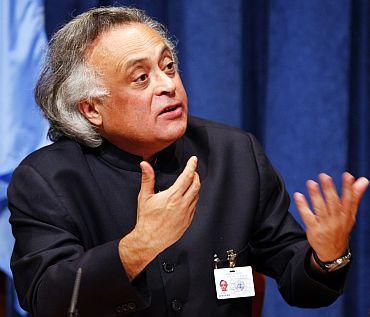
Union Rural Development Minister Jairam Ramesh lays out the roadmap for rural growth --- without mincing words.
I have just completed 100 days in the rural development ministry. It's a gigantic ministry. Its total budget is around Rs 100,000 crore, which makes it India's second largest ministry after defense, which spends around Rs 170,000 crore.
In the civilian sector, rural development is the single largest spending ministry. Many big programmes like the National Rural Employment Guarantee Act, the Pradhanmantri Gram Sadak Yojna and a host of other programmes related to housing, water supply and sanitation are run by us.
This is a gigantic ministry, but the federal government's role is largely confined to financing the states and monitoring the finances. But the real implementation of our programmes is almost entirely with the state governments. In that respect, it is a spilt responsibility.
Financing, very largely, comes from the Centre but the implementation is entirely the responsibility of the states.
As told to Sheela Bhatt
Please ....
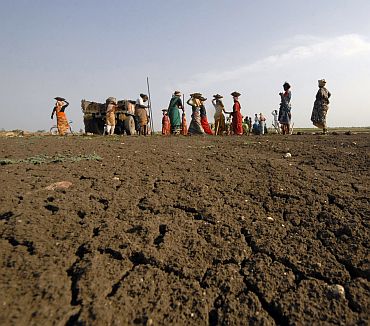
I have visited eight states so far. I have brought the Land Acquisition Bill to Parliament. In this ministry, you have to have your sense of priority otherwise you can get completely lost. The Pradhanmantri Gram Sadak Yojna is the most important programme for the rural connectivity that provides roads to villages.
We have finished 60 percent of the programme, but 40 percent remains to be done. That is, clearly, top of my list. Secondly, the Rural Employment Guarantee Act's implementation is vey patchy and uneven. We had NREGA 1.0, and now we should have NREGA 2.0. It needs reforms.
Some states are doing good -- like Andhra Pradesh -- and some states like Uttar Pradesh are not doing well. But it's wrong to condemn the programme unilaterally. On three issues there are incontrovertible evidences to support NREGA.
Agricultural wages have gone up. It's a good thing because only that will help decrease rural poverty. Part of the propaganda against NREGA is coming from landowners who are unable to get cheap labour.
In many parts of India, amount of cultivable land has gone up. Barren land has come under cultivation. Three, distress migration has come down because people have found jobs around villages.
It is an intellectually lazy argument to say that there is corruption in the NREGA. The NREGA is not all about corruption. It's there, but 70 percent of the NREGA budget has created visible assets like water structures, etc. NREGA is the employment of last resort. It's a demand-driven scheme. It's for unskilled labour who can't get jobs elsewhere. It is creating community assets.
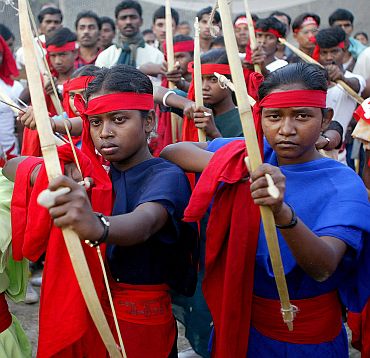
Thirdly, I am trying to bring cautious focus on Naxalite affected districts. We have identified the 60 districts which are core of the Naxalite (Maoist) violence area spread across seven or eight states. I am trying to bring in rural development as an instrument to combat the Maoist ideology to support, to compliment and to consolidate whatever action is taken by the police and paramilitary forces.
Orissa, parts of Madhya Pradesh, and Jharkhand are states where tribal, forest and mineral issues are pending to be resolved.
Fourthly, I would say sanitation is on top of my mind. To my mind it's important and it's my real concern. 60 percent of all open defecations in the world are in India. It's a blot, it's a shame. It's a social problem. You have to increase awareness.
Good sanitation leads to good health and good health leads to better quality of life. I have seen women in India with a mobile phone in one hand and lota (vessel to carry water for toilet) in the other and going into the fields. That's not the India that we want.
We have to build more toilets. Where we have built toilets, people are not using it. So, we have to get into culture to make people use toilets. In our Indian culture, we are comfortable with filth and squalor. Out of 600,000 villages in India only 24,000 villages are Nirmal Gram (open-defecation free villages).
The paradox of India is that we have individual hygiene but collective filth. There is private cleanliness, but public squalor. We are comfortable with this great paradox of India.
We bathe twice or thrice a day, but we take trash from our houses and throw it outside. Sanitation is not just about money. Of course, we have to invest in it. Our total investment in sanitation is just 1 or 1.5 percent.
We spend only Rs 16 billion on sanitation. If I had more money, I would certainly first spend it on sanitation and, second, on rural roads.
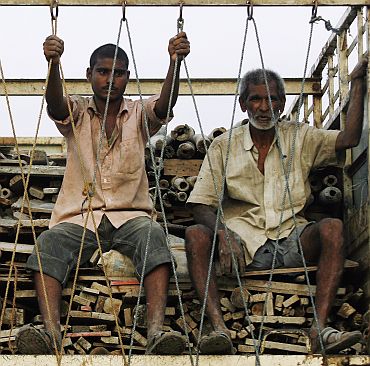
Connectivity is the key in the rural development. Our land bill is also path-breaking. For the first time the bill talks about compensation not just for landowners but also landless labourers. We are being criticised for being too progressive.
I am not romantic as far as villages in India are concerned. I believe in faster urbanisation. Most people in India seem to see urbanisation as a threat. I see it as an opportunity.
We should accelerate urbanisation. There are many benefits of urbanisation. There are social and economic benefits. There is no question of romanticising village life. Read what Dr (B R) Ambedkar has to say about Indian village life. I still remember his ringing words.
Yes, we have a challenge. We have 75 percent of our population living in 600,000 villages. Unless we have rural prosperity we won't prosper. Urban prosperity is dependent on rural prosperity.
There are no magic bullets. There are no magic formulas to improve Indian villages. We have no shortage of programme or money. I don't get into policy changes and the vision thing. I am a man of nuts and bolts. I have a job to do. I have nine flagship programmes. I have to make sure that I prioritise what I am doing.
I disagree that we are not doing enough. Whoever is talking such thing is talking through his/her hat. We are spending Rs 1,000 billion on rural development. I agree that results on ground are not commensurate with the amount of money spent, but that doesn't mean rural development is neglected.
I agree that there are disparities between urban and rural India. The process of wealth creation is inherently non-egalitarian. In initial years of rapid economic growth, inequality is an inevitable consequence. It's a heartless thing to say, but inequality in initial years of rapid economic growth is the price we end up paying unless we create equal opportunity by giving education, health, etc.
In an inherently unequal society like ours, the process of growth can accentuate this inequality. That's the job of the government -- to ensure that process of growth is inclusive.
Rural and urban divide, the digital divide, is there but it's not new. I would say economic growth has not percolated fast or deep enough, but you can't say it has not percolated at all.
I go to a large part of India where you don't see fruits of India's economic growth. I was in Ghumla village, about 37 miles from Ranchi (Jharkhand). There was no mobile service over there; so what are we talking about?
There are parts of India that have got bypassed in our rapid growth but that's not the argument for slowing down growth. That's the argument for broad-basing economic growth and creating infrastructure.
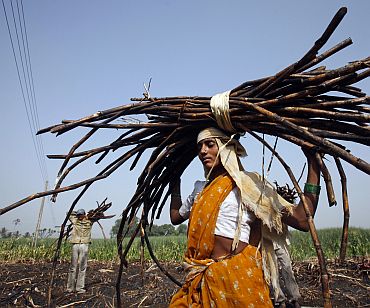
I don't believe in 'self-sufficiency' of villages. I believe in 'inter-dependency' of villages, which has broken down the caste system. The inter-dependency has increased aspirations of people.
My views of self-sufficiency of Indian villages are closer to Dr Ambedkar than they are to Mahatma Gandhi. My personal view is that we should bring villages into the mainstream, into the larger web of economic growth.
This business of self-sufficiency of villages may have had relevance at one point of time but it also led to highly iniquitous social factors.
These days, there is demographic pressure on land so people are migrating. However prosperous agriculture would be, all people in villages cannot be absorbed in agriculture. You will need to create non-agro jobs.
I don't see any reason why we should prevent migration. People will keep migrating from villages to hinterland and from there to towns and cities. I welcome it. However, we should not neglect rural development.
We are doing rural development not to keep people in rural areas. The important thing is we are doing rural development in order to create larger centers of prosperity.
But, there is a huge challenge of rural development because of demography. Again, I would say connectivity is the important thing. We have 250,000 panchayats (second rung of India's three-tier rural administration system).
Why should they not be connected with broadband? The project to connect panchayats is going on and on.
My view is that it's good that rural people are coming out. They see urban areas. They have new aspirations. They are better educated. Caste barriers begin to break down. These are good things associated with urbanisation. The cost of providing urban infrastructure is lower -- because there is economy of scale -- compared to rural infrastructure.
Also, you must understand that urbanisation requires land. You can't grow cities in the air. We need faster industrialisation and we need to see that more and more people get out of land-based occupation and join manufacturing and services. Even after 60 years of independence over half of our rural population is in agriculture. This is not a desirable state of affairs.
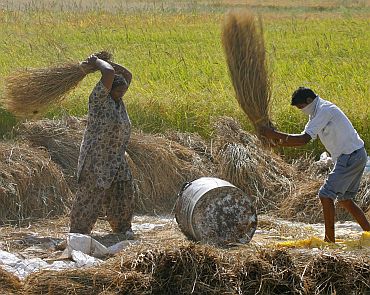
Agriculture is supporting a huge population, but demography and economies of the agri- industry is such that you can't drive people out of poverty by agriculture alone.
You need non-agricultural employment. The government is attending to villages in various ways. We have decided to give more power to gram sabhas (rural administration office) to decentralise power.
Already, money to implement NREGA is going straight to panchayat samitis (link between village administration and district administration). In fact, state governments are complaining that they have no role in it.
We have now started a programme under which each panchayat will get one development officer and one junior engineer. The Centre will bear 75 percent of the expenses of employing them. This is one way to create technical capacity in villages, who will see to it that NREGA money is spent in creating national assets.
We are investing in local bodies. We haven't been able to do this so far because the central government is keen to decentralise, the state governments are not particularly keen to decentralise. At the recent National Development Council meeting, not one chief minister spoke about decentralisation of power.
In my view, the first phase of India's ideal of decentralisation has been very successful; this was to create a large base of elected representatives. We have over 3 million elected representatives all over country, out of which 40 percent are women.
There are three R's of a democracy: It has to be Representative, Responsible and Responsive. So far, our democracy is Representative. Now, we have to become Responsible and Responsive.
Unfortunately in India, we have become prisoners of romantic ideologies. Urban is bad, rural is good. Small is beautiful, large is ugly. We should learn to become more pragmatic. Let us be less argumentative. We should be little less worried about ideologies.
Remember what Deng Xiaoping said once: How does it matter if the colour of the cat is black or white as long as it catches mice. If I had to make a statement in India there will be a furore! They will say forward cat, backward cat, some will say small-scale cat, there will be talk of large-scale cat, there will urban cat and rural cat and global cat and local cat.
The whole debate will be on the nature of the cat, while the mice will proliferate.